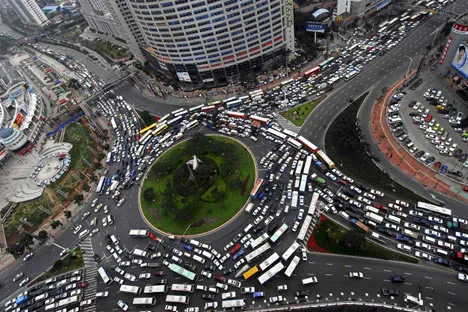| The level of bearishness towards China has increased considerably in the past few weeks. The Chinese A- and H-share indexes have fallen by 14% and 12% respectively since their recent peaks in early April . Even European, US and Japanese stocks that are perceived to be particularly dependent on Chinese demand, notably in chemicals, commodities and autos, have underperformed. In Hong Kong, short trades have exceeded 10% of turnover in recent days, as high as the peak during the 2008-9 crisis. And flows into mutual funds focused on China have been negative since last December; since then they have suffered USD2.3bn worth of outflows. Investors’ key worry is that China is heading for a nasty hard landing, caused by a combination of excessive tightening to fend off inflation, and the structural side-effects of all the stimulus done in 2009 - the bursting of the property bubble, and a big increase in banks’ non-performing loans to local governments. It is not easy to define what investors are thinking of when they talk about a “hard landing”. But we would roughly define it as a decline in GDP growth to below 7%, and industrial production to
below about 10%. One of the major triggers of this concern among investors was the recent fall-off in the HSBC
China PMI, which slipped to 51.6 in May and 50.1 in the flash reading for June from 55.3 last
November. That sounds a very low number – after all, the US ISM, even after its recent nasty drop, is still at 53.5. One has to be very careful with PMI-type indexes, however. Their trend matters more than the
absolute level – especially in cross-country comparisons. In fact, the current level of the China PMI is similar to that in 2005-6, when GDP was growing 10-11%. Our economists argue that the current level is easily compatible with about 9% growth in GDP and 13% growth in industrial production. What is happening on the ground?
Clearly, the question of whether China is really slowing precipitously is a key issue for global
stock markets. So we asked our analysts in Asia and Europe who cover sectors with especially high exposure to China to tell us what data in their industry is showing and what their ompanies are seeing on the ground. We also asked our China economist, Qu Hongbin, to analyse how rapidly Chinese growth is slowing, and to give us his outlook for the coming quarters. The results, as one would expect, are to a degree mixed. There are certainly some signs of a
slowdown. At the macro level, as Hongbin describes in his section, key data has all softened
somewhat: new bank lending, for example,slowed to 17% y-o-y in May from 18.5% at the
beginning of the year. But he believes this is merely a sign that quantitative tightening is
working. He argues that inflation, not growth,remains the key macro risk. Slowdown? Yeah, right
And if you are worried about a slowdown,consider the following Chinese data points: •Chinese machine tool production was up 45% y-o-y in May.
•Same store sales of major department store chains rose 18-30% y-o-y in 1Q, with consumers particularly keen to buy gold and jewellery.
•Sales of jewellery were up 43% y-o-y in May and furniture 26%
•Sales of Mercedes cars are up 68% y-o-y so far this year, despite the stagnation of the auto market overall.
•Fixed asset investment by local governments rose 28% y-o-y in the first five months of the year.
•The government is to build 36 million social housing units over the next five years, including RMB850bn worth where construction will begin in the next six months.
•China’s oil demand this year so far has risen 10.6% y-o-y, almost 60% above the IEA’s projection at the start of the year.
•For global metals demand to fall, our analyst calculates that China’s GDP would need to grow at less than 5%. Any more than 8% GDP growth, and global supply/demand for most metals remains tight.
•The number of Chinese 3G mobile phone subscribers has risen by 256% y-o-y so far this year as Chinese consumers begin to warm to data services.
•Household penetration of PCs is still only about 15%
•Our analyst estimates new demand for residential property in China is 1bn sqm a year. That is 12 times the size of Manhattan. | 



![SBR 5 Lorem Ipsum News 2 [8 May]](https://cmg-qa.s3.ap-southeast-1.amazonaws.com/s3fs-public/styles/exclusive_featured_article/public/2025-05/a_hand_pointing_to_a_futuristic_technology_5b87c9d0e3_3.png.webp?itok=M3Hf-9XR)
![SBR 4 Lorem Ipsum [8 May Top Stories]](https://cmg-qa.s3.ap-southeast-1.amazonaws.com/s3fs-public/styles/exclusive_featured_article/public/2025-05/a_hand_pointing_to_a_futuristic_technology_5b87c9d0e3_2.png.webp?itok=2m5Wl0MX)


![Exclusive three SBR 12 Lorem Ipsum [8 May]](https://cmg-qa.s3.ap-southeast-1.amazonaws.com/s3fs-public/styles/exclusive_featured_article/public/2025-05/a_hand_pointing_to_a_futuristic_technology_5b87c9d0e3_11.png.webp?itok=8kn_UIfA)
![SBR 3 Lorem Ipsum [ Exclusive 2]](https://cmg-qa.s3.ap-southeast-1.amazonaws.com/s3fs-public/styles/exclusive_featured_article/public/2025-05/a_hand_pointing_to_a_futuristic_technology_5b87c9d0e3_1.png.webp?itok=YCyjLegJ)
![SBR 2 Lorem Ipsum [8 May]](https://cmg-qa.s3.ap-southeast-1.amazonaws.com/s3fs-public/styles/exclusive_featured_article/public/2025-05/a_hand_pointing_to_a_futuristic_technology_5b87c9d0e3_0.png.webp?itok=_cKD-29o)

![Video [Event News]](https://cmg-qa.s3.ap-southeast-1.amazonaws.com/s3fs-public/styles/event_news_featured_article/public/2025-05/screenshot-2025-05-08-at-4.58.53-pm_0.png.webp?itok=Kud35sMs)
![Event News SBR 9 Lorem Ipsum [8 may]](https://cmg-qa.s3.ap-southeast-1.amazonaws.com/s3fs-public/styles/event_news_thumbnail/public/2025-05/a_hand_pointing_to_a_futuristic_technology_5b87c9d0e3_8.png.webp?itok=DTh_dbYp)
![Event News SBR 9 Lorem Ipsum [8 May]](https://cmg-qa.s3.ap-southeast-1.amazonaws.com/s3fs-public/styles/event_news_thumbnail/public/2025-05/a_hand_pointing_to_a_futuristic_technology_5b87c9d0e3_7.png.webp?itok=vzDAzb6V)
![Event News SBR 8 Lorem Ipsum [8 May]](https://cmg-qa.s3.ap-southeast-1.amazonaws.com/s3fs-public/styles/event_news_thumbnail/public/2025-05/a_hand_pointing_to_a_futuristic_technology_5b87c9d0e3_6.png.webp?itok=jvHFc4P6)
![Video [Event News]](https://cmg-qa.s3.ap-southeast-1.amazonaws.com/s3fs-public/styles/video_thumbnail/public/2025-05/screenshot-2025-05-08-at-4.58.53-pm_0.png.webp?itok=yZnI0YBb)
![Video 1 SBR [8 May]](https://cmg-qa.s3.ap-southeast-1.amazonaws.com/s3fs-public/styles/video_thumbnail/public/2025-05/screenshot-2025-05-08-at-4.58.53-pm.png.webp?itok=9AAeRz_k)

 Advertise
Advertise

